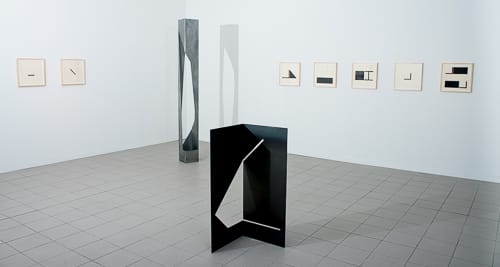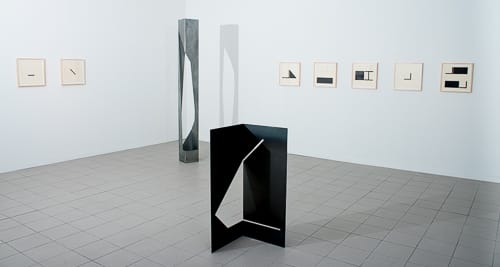
Dichotomy
Kenneth Capps
Oceanside Museum of Art
Oceanside, CA
Review by Cathy Breslaw
Standing among the free-standing sculptures, ink on paper and steel drawings, and wall sculpture works by Kenneth Capps, we are reminded of artists Brancusi, Donald Judd and Robert Morris whose works fed the engine of minimalism during the mid to later twentieth century. Capps continues that line in his homage to this movement in his highly focused art practice of the past four decades. Known for his wood and steel public art, in this exhibition Capps highlights steel and chrome, and ink on paper as his primary materials while the sphere, triangle, and square become his primary shapes. Therein he explores the opposites of forms: rectilinear/curvilinear,convex/concave, positive/negative, and open/closed spaces. “Line” is the common denominator in all the works shown, whether they are painted, drawn or cut into steel or chrome. His lines travel in many directions, often bursts of short lines of varying thicknesses cut into steel that move in and out of three dimensional space within surfaces. While the works are limited in their color palette to mostly black, and dark steel, there is an array of surface variations of polished and shiny chrome, dull, and subtle modeled areas. There is also an investigation of space in both the works on paper and sculpture. Capps’s works on paper appear to be more of a way of exploring line and symbols in preparation for creating sculpture than stand alone pieces. There are three drawings on paper that stand apart from the others which are “Cast”, “Study for D Side” and “Study for the Distortion of the Square”, all created in 1975. These ink drawings reveal the ‘hand of the artist’ as they are roughly drawn, possess variations in color tones and exhibit mark-making rather than the straightforward filled in lines of his other drawings. Simplicity and economy of design best describe Kenneth Capp’s work in this exhibition.



